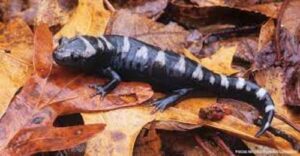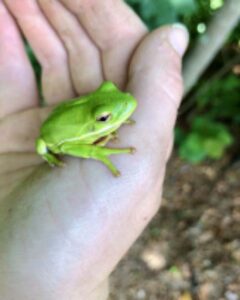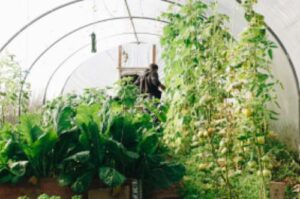Environmental Education Outside the Classroom: The Campus as Haven for Environmental Learning
 When I was small, I would spend hours roaming about the woods like a mouse. Or scurrying like a fox, hunting for small creatures just under thick leaf litter. Quickly, I learned to avoid the heavy-trod paths of hunters and, more imperatively, the loggers and trucks that would leave what seemed to be endless expanses of torn land where the sun quickly bleached any remnants of plant life. As people surrendered more and more of their land for clearing, my forested realms dwindled into islands.
When I was small, I would spend hours roaming about the woods like a mouse. Or scurrying like a fox, hunting for small creatures just under thick leaf litter. Quickly, I learned to avoid the heavy-trod paths of hunters and, more imperatively, the loggers and trucks that would leave what seemed to be endless expanses of torn land where the sun quickly bleached any remnants of plant life. As people surrendered more and more of their land for clearing, my forested realms dwindled into islands.
 I found my backyard an island. Not only did it provide a sanctuary for me, but it acted as a refuge for passing and resident wildlife that sought shelter from the development and logging disrupting their homes. Converting whatever spaces I could into habitat and feeding grounds enticed even the shyest of creatures to visit. This concentrated exposure to nature furnished my first taste of environmental education and solidified my connection to the world around me.
I found my backyard an island. Not only did it provide a sanctuary for me, but it acted as a refuge for passing and resident wildlife that sought shelter from the development and logging disrupting their homes. Converting whatever spaces I could into habitat and feeding grounds enticed even the shyest of creatures to visit. This concentrated exposure to nature furnished my first taste of environmental education and solidified my connection to the world around me.
Naturally, when it was time to leave my home to earn a degree, I was drawn to a college campus that offered the same islands of connection to the natural environment. The gardens, ecological preserve, and secluded “green” building on Catawba College’s campus are my, and many other students, islands. One thing that has surprised me is the number of students unaccustomed to — and amazed by — positive interactions with serene environments where one can interact with the wonder of our world.
Environmental science and biology majors often say that frequenting these locations renews their inspiration and desire to study the sciences. Even students outside of the science majors seek out green, sustainable spaces to study and assemble. The connections I make simply being in such spaces allows me to join and strengthen networks of like-minded students. It is apparent that such natural havens hold more value than just appearance — they inspire, teach, and build community.
The importance of environmental education cannot be overstated. As the ecology of our world becomes increasingly unstable and inhospitable, we need to know how to build resiliency and innovate to overcome environmental challenges posed by the unceasing production of goods and emissions from fossil fuels. Environmental education is often administered through formal learning — classes in a school, for instance. However, if sustainable actions are to become behaviors and habits, they must be consistently reinforced by our environments and everyday interactions.
The nation’s schools and college campuses can be tools for teaching sustainability and environmental and social responsibility. Approximately 53 million students attended K-12 schools and 19.6 million students attended colleges and universities in 2020. In 2020 (pre-pandemic), roughly 72 million people were spending time on campuses across the United States. 72 million individuals, many of whom are hungry for knowledge and receptive to ideas. It is obvious that schools are important places for learning environmental sciences and sustainable practices, but this mindset needs to break free of the classroom.
There has been a push for campuses to become living laboratories, places that stretch the boundaries of environmentally and socially sustainable technology and design. A study conducted in 2017 with grade school students ages 10 – 12 found that children had considerably higher pro-environmental attitudes if attending a school designed for sustainability. A building’s design can be educational in itself — particularly if supplemented with information stations like smart boards that provide information on the building’s energy use, or open-framed designs that highlight eco-friendly building materials. Even dormitories can display eco-friendly design and teach residents sustainable lifestyles; for instance, the Treehouse at Dickinson College, PA. (the first LEED Certified building of its kind in Pennsylvania), introduces students to communal living, green technologies and energy, and provides a space for residents to host events to showcase what they’ve learned.
Campuses can also take sustainable design out of the building and into outdoor spaces. Green spaces throughout campus, including gardens, greenhouses, walking trails, and open greens not only invite students to be active or tranquil in the presence of nature, but double as functional spaces for growing food or encouraging a connection to place. Gardening and other outdoor activities improve physical wellbeing, and only 20 minutes of exposure to nature can enhance concentration, increase cognitive and recall functions, and improve overall performance in school. Students can learn to recognize the importance of interacting with nature — if they are given the chance.
While the design and functionality of sustainable spaces is important, it is only part of the equation — recycling, gardening, and other behaviors can only go so far within the constraints of our society. That is why campuses must act as hubs for learning to be politically engaged, ecological citizens. Spaces like campuses are incredible resources for building networks and communities. The Covid 19 pandemic illustrates this particularly well, at least at Catawba. For our safety, the height of the pandemic sent us home. Try as we might, communicating through small boxes on a screen could only take us so far. Most clubs and environmental organizations perished during our time away from campus, leaving us the difficult task of networking and reorganizing to bring groups back together upon returning to campus.
As soon as the 2021 school year began and we were able to congregate in our sustainable buildings, gardens, and other islands, our groups and networks have flourished, amassing a community of students, professors, and others of all disciplines dedicated to environmental and social responsibility. A community like this goes beyond mobilizing students for climate action; it embeds within them the knowledge and tools that will help them navigate an increasingly difficult, rapidly changing environment and spread ecological awareness into their own communities.
I consider myself lucky to have had the exposure to nature and the desire to understand the world around me that arose from my childhood spent in the woods. Not everyone has access to such experience. It is vital to allow all students space to connect with their environment and the chance to learn about the issues we face as a species — issues like climate change and biodiversity loss — that will only intensify throughout their lifetime. The future we are moving into requires that everyone learn to listen to our environment. Maybe if our schools, colleges, and universities shifted focus to emphasize a sustainable lifestyle and ecological mindset, these behaviors and beliefs would seep into other areas of society and train the next generation to build a better future.
As a student, I feel that it is a duty to help others experience the wonder and vibrance of the world around us. As an activist, I feel that it is important to help others become aware of environmental issues and how our societies can negatively affect the natural processes that keep us all alive. Students, activists, teachers, and others associated with schools can utilize existing campus green spaces to teach and build community, as well as push for their campuses to commit to ‘going green’ and beyond, with new technologies, smarter building designs, and more exposure to nature interweaved in the campus’s design. By doing so, you are readying and aiding not only your generation, but generations after. If you are a student, teacher, donor, or someone otherwise affiliated with a school or place of learning, the question I posit to you: how are you shaping the future?
 RCC Fellow — Willow Gatewood — Catawba College
RCC Fellow — Willow Gatewood — Catawba College
Willow Gatewood is a junior at Catawba College studying Environment and Sustainability, with minors in Creative Writing and GIS. She is also an intern and work-study for the Catawba College Center for the Environment and involved in environmental and climate advocacy groups.
![]() The Rachel Carson Council depends on tax-deductible gifts from concerned individuals like you. Please help if you can.
The Rachel Carson Council depends on tax-deductible gifts from concerned individuals like you. Please help if you can.
![]() Sign up here to receive the RCC E-News and other RCC newsletters, information and alerts.
Sign up here to receive the RCC E-News and other RCC newsletters, information and alerts.












